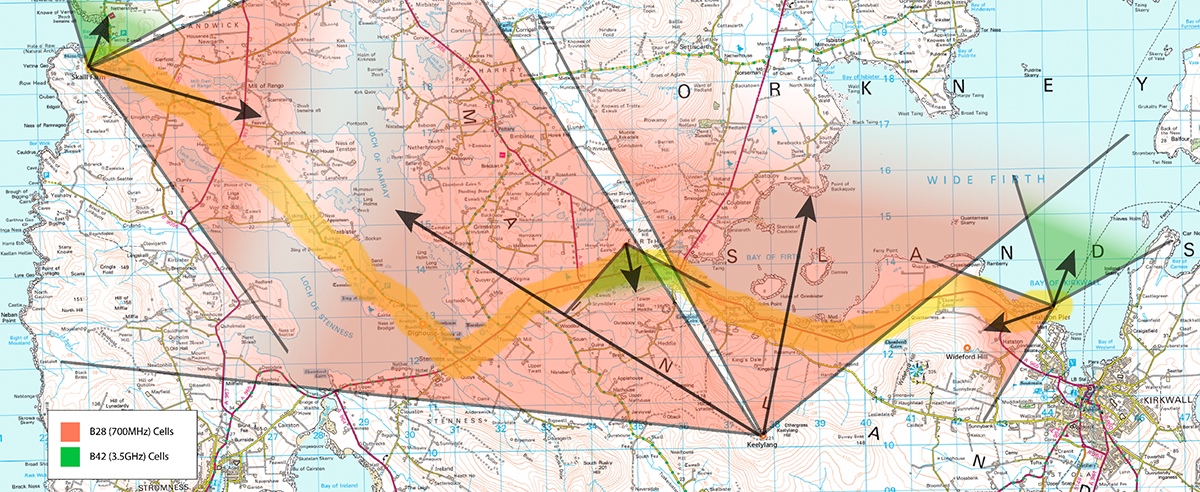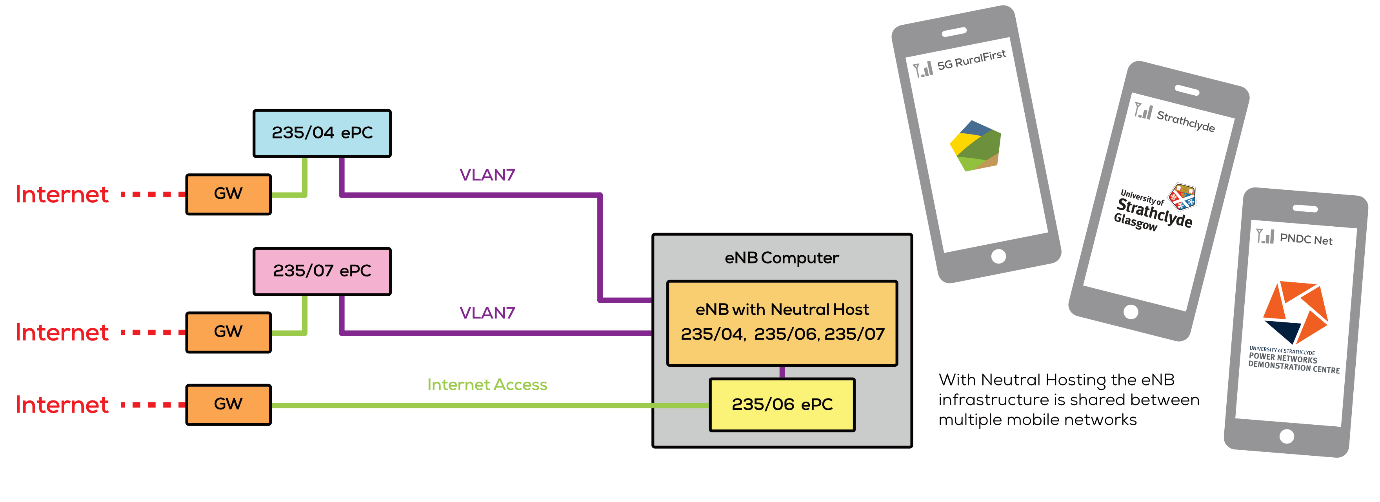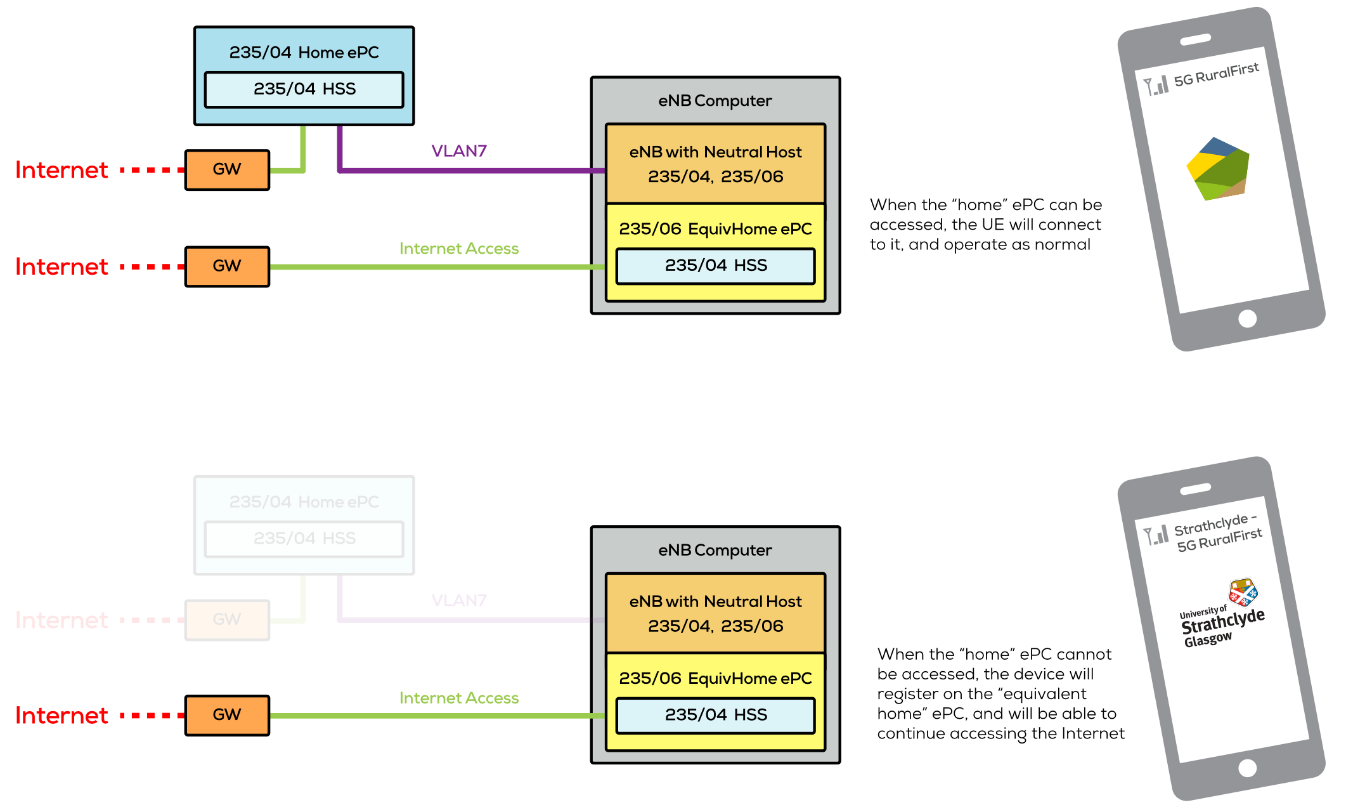Greig Paul, Kenneth Barlee, Ross McPherson, Dani Anderson, David Crawford, James Irvine, Robert Stewart, University of Strathclyde, Glasgow
First appeared in IEEE Future Networks Tech Focus, Volume 4, Issue 1, November 2020
1. Introduction
While much of the focus of 5G deployment has been around higher frequencies supporting greater bit rates, the 700MHz spectrum allocation for 5G offers the opportunity of wide area coverage of rural areas. However, even at these lower frequencies, rural deployments face economic challenges. An existing market driven approach has not provided good coverage, nor have regulatory interventions via coverage obligations [1]. In Scotland, the government intervention aimed to provide shared masts to help solve the connectivity problem; however, 56% of the originally proposed sites have now been dropped due to lack of mobile operator interest, and only a single ‘infill’ site is currently operational [2]. This is in part because of the high cost of providing radio equipment and backhaul—even with Government intervention funding, there was no economic case for operators to install coverage in sparsely populated areas.
Neutral hosting has the potential to solve this problem. Under this system, a single eNB broadcasts a number of different network identities, and is connected to multiple core networks, so that customers for many networks will see their ‘home’ network without roaming. Connections are then routed from the eNB back to the relevant home network for processing. While the ability to present multiple network configurations over the air interface has been present in the standards for some time, the network structure of 5G makes connection to multiple core networks easier.
5G RuralFirst (5GRF), led by Cisco Systems Ltd alongside principal partner University of Strathclyde, was one of six projects in the first phase of the UK Government’s Department for Digital, Culture, Media, and Sport (DCMS) 5G Testbed & Trials programme. The project ran from March 2018 to September 2019, and developed a range of technology trials and use cases to explore the potential for rural 5G deployments. The overall aim of the project was to support and inform development of the UK’s 5G eco-system to address the needs and aspirations of rural communities and businesses [3].
The project deployed a 4G/5G network on the Orkney Islands, an archipelago off the north coast of Scotland, with a population of 22,000 spread over 70 islands across a total area of just under 1000 km2. The population density is similar to Arkansas and higher than that for the Highlands and Islands as a whole (12 people per sq. km) but lower than the Scottish average (70 people per sq. km). The main focus of the deployment was coverage of a tourist bus route from the cruise ship terminal near Kirkwall, the main town on the islands, the Ring of Brodgar and Skara Brae, both of which are world heritage sites. Coverage was provided through a combination of three 700MHz eNBs covering the majority of the route and a further three 3.5GHz eNBs providing infill coverage and high bandwidth provision at each end of the route where tourists congregate for some time (Figure 1).

Figure 1: Tourist route across Orkney. Contains OS data © Crown copyright and database rights (2019)
2. Lab-Based Implementation
In order to create a realistic lab-based test environment, a series of Software Defined Radio (SDR) based eNBs were configured to act as separate eNBs in a network. Three software-based ePCs were configured, one for each mobile network identity. This meant that, for each mobile network, an independent MME and HSS was present to handle device identities and mobility across the network. This emulates a realistic scenario with multiple independent mobile networks being connected to the eNBs.
Three PLMNs were obtained from the UK telecommunications regulator, Ofcom—235/04, 06, and 07. These PLMNs were used to operate three separate network identities, and SIM cards were internally provisioned with keys and configuration parameters for each respective network.
Multiple IP subnets were created in the lab network, in order to provide independent networks for each of the separate core networks. Inter-network connectivity was verified through establishing an S1 connection from each eNB to all three ePCs, enabling control plane signalling traffic. As cell specific radio parameters, such as transmit power are configured per eNB there is no requirement for an ePC to configure the radio under this scenario, meaning that no ePC is defined as having an elevated level of control or significance over the others. The connection logs on each ePC were used to verify that each of the three eNBs had connected successfully and established an S1 connection.
End-to-end packet connectivity was established by inserting a SIM card into a handset, and programming an APN corresponding to the ePC that the SIM card was configured to join. Using these handsets data connectivity was then tested where each ePC provided either a connection to the public internet, or connection to a local network, which would allow for local traffic break-out which would allow for dedicated services and reduced latency.
To verify cross-core interoperability, two of the ePCs was replaced, one using open source srsLTE ePC [4], and the second using an external commercial operator-grade core, and three handsets each configured for their respective ePC were simultaneously tested through a series of performance tests, and standard user mobile interactions (e.g. streaming video, and messaging). This demonstrated seamless operation of the eNB while being simultaneously connected to the multiple diverse LTE cores.
3. Approaches to Network Selection in a Neutral Hosted World
One significant aspect of implementation of a neutral host based network is the handling of network selection—a key use-case of neutral hosting which has been envisaged in the past has been the idea of rural neutral hosting as an alternative to rural roaming. To provide a seamless user experience under such a scenario, it is important to design for the scenario where users enter into, and leave from, the neutral host network’s area of operation. We envisage a scenario where a neutral host operator provides a service across a rural geographical region, and users enter and leave this area, using an LTE core network provided by an external mobile network operator that does not provide sufficient coverage within the rural area of coverage. We also envisage that some operators may be concerned, on grounds of customer support and quality of service, to have their brand associated with a neutral host network run by a third party. For this reason, we designed this trial to determine whether a per-operator third-party PLMN would work correctly with a SIM card in a real device.
To verify that this model would function correctly in the lab, we implemented Equivalent Home PLMN (EH-PLMN) functionality on the SIM card, such that the handset would join a network with an identity of either the main network, or the equivalent home network. When registered to the EH-PLMN, the network identity was presented on the handset’s operating system network banner was “EHPLMN – PLMN”, i.e. “ThirdPartyNetwork – HomeNetwork”. In light of the equivalence of the PLMNs, the handset was verified to move between networks successfully, based on the availability of the third party network. Note that this roaming-based approach does not provide for seamless mobility between the neutral host network and the main network. However, a properly configured network presenting the same PLMN identity as the main mobile network does allow seamless roaming. This highlights a key outcome, at least for this early stage of the work, in that for a neutral host network to offer a seamless and uninterrupted user experience, it should advertise itself using the main mobile network’s identity.
4. Field Deployment
In the Orkney-based field deployment, the main network’s ePC (235/04) was deployed at the local fibre exchange. An additional ePC (235/06) was deployed on one of the eNBs which acts as an aggregation point for the microwave backhaul across the network. Each eNB in the field also ran an instance of a local ePC (235/07), for local diagnostics and monitoring, such as to provide remote access to the eNB console and log access.
Using a custom orchestration and provisioning system, each eNB was provisioned with an appropriate configuration, notifying it of the networks to serve, the radio parameters to use, and the network configuration for the eNB to utilise on the backhaul network.

Figure 2: Deployed neutral host configuration
A SIM configured with PLMN 235/04 and EHPLMN 235/06 was inserted to a handset, and connected to an eNB. The UE joined the main 235/04 ePC as expected. Next, the Ethernet connection to the backhaul network for that PLMN was removed. This simulated a backhaul network outage/ core configuration issue. The UE displayed ‘emergency calls only’, the standard message when there is no service available. Toggling the UE in and out of flight mode, the phone re-registered onto the alternative 235/06 ePC running locally on the eNB itself, and was able to access the WAN (and Internet) via a secondary Ethernet connection served by a different VLAN.
This experiment demonstrated that a ‘failsafe’ mobile network could be run using a neutral host based approach. When running in this mode, ePC and eNB initiated handover would no longer work; resulting in a brief loss of service when travelling between coverage areas of different eNBs. However, the ability to maintain Internet access, via an independent backhaul service such as satellite broadband, would allow the network to stay up in an emergency situation (provided there was power to the eNB). This could be greatly beneficial to first responders, for example, or in natural disaster situations. One issue that requires further research would be the security of the HSS data, as this would need to be present either on each base station computer, or on a remote system reachable by the alternative resilient backhaul.

Figure 3: Failsafe-self neutral host configuration, showing how an Internet connection is maintained when home ePC backhaul goes down
5. Conclusions
Our work has shown that neutral hosting can work with standard mobile phones which are on the market today, and with only software reconfigurations to a mobile core networks. This demonstrates that from a technological point of view, neutral hosting is a practical solution for rural network provision.
The non-technical issues relating to equipment sharing are likely to prove more challenging. While neutral hosting means that multiple networks can be provided over a single set of equipment, an effective cost sharing model is more difficult given the high initial deployment costs. Historical challenges around operators’ quality of service concerns need to be explored, although an alternative approach to help mitigate this has been shown, using a secondary PLMN for third-party networks offered on behalf of the main network.
In addition to demonstrating Neutral Hosting, our experiments show that it is also possible to provide fall-back connectivity, either using an ePC on the eNB itself (and an extra backup backhaul internet connection), or via an ePC located elsewhere and reached over this fallback backhaul, which may include low-earth orbit satellite or similar. Such a fall-back solution, combined with suitably designed services, could significantly increase network resilience, for example in the provision of private networks for the utilities.
References
- Ofcom, “Mobile coverage obligation”. [Online]. Available: https://www.ofcom.org.uk/spectrum/information/cellular-coverage [Accessed 23 February 2020].
- Scottish Government, “Scottish 4G infill programme: progress update”. [Online]. Available: https://www.gov.scot/publications/scottish-4g-infill-programme-progress-update/ [Accessed 20 February 2020].
- 5G RuralFirst, “About 5G RuralFirst” webpage. [Online]. Available: https://www.5gruralfirst.org/what-is-5gruralfirst/. [Accessed 15 January 2020].
- srsLTE, “srsLTE: Open source SDR LTE software suite from Software Radio Systems (SRS)”. [Online]. Available: https://github.com/srsLTE/srsLTE. [Accessed 21 February 2020].
Biographies
Greig Paul is a technical lead on the 5G RuralDorset project, building on the innovations of the 5G RuralFirst network and applying these to other use-cases, as well as a consultant and advisor to mobile operators, local authorities and Governments on security for mobile networks.
Kenny Barlee is a researcher in the Software Defined Radio research laboratory, currently working on the design and implementation of a new 5G NSA/SA network for the 5G NewThinking project that will be used for fixed wireless access broadband and neutral host cellular services.
Ross McPherson is completing a Ph.D. degree in cyber security of IoT devices. Focusing on the practical development and usage of devices without detracting from the existing user experience, he is particularly interested the diminishing financial barriers to deployment.
Dani Anderson is a Research Assistant whose research focuses on the development of Rural Broadband solutions, specifically looking at Dynamic and Shared Spectrum technologies and Software Defined Radio. His recent projects include 5G RuralFirst, 5G RailNext, and 5G NewThinking projects.
David Crawford is the Director of the Centre for White Space Communication and the Strathclyde Manager for UK Govt supported projects, 5G RuralFirst and 5G NewThinking projects working on new business models and technologies for rural connectivity.
James Irvine is the Academic Lead for the Communications Theme of the Power Network Demonstration Centre, looking at the application and security of 5G networks within the utility sector. He is Executive Vice President of the IEEE Vehicular Technology Society.
Bob Stewart is a Professor at the University of Strathclyde and has been working with key industry partners on software defined radio for the last 20 years, with a specific emphasis on the PHY layer and FPGA implementations.

